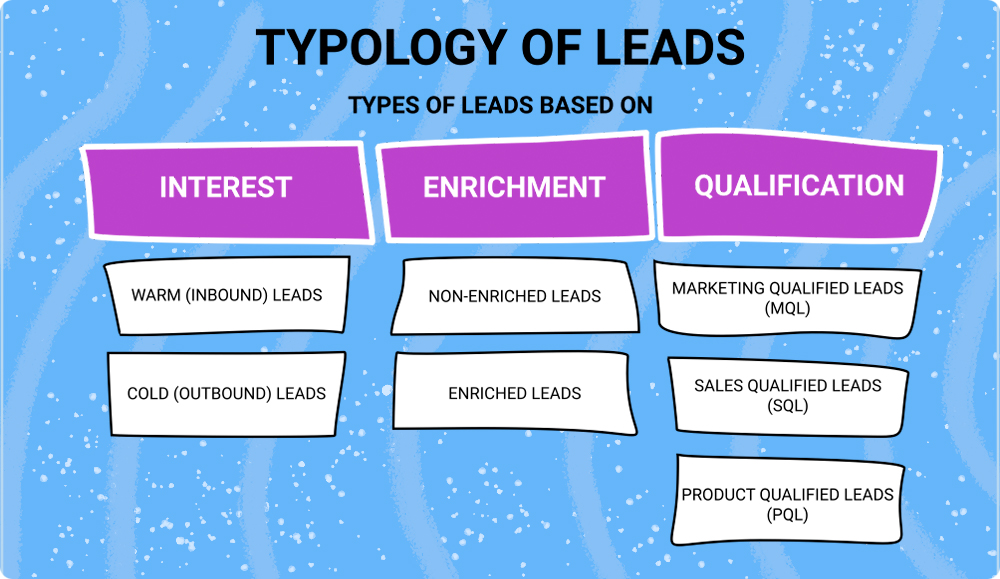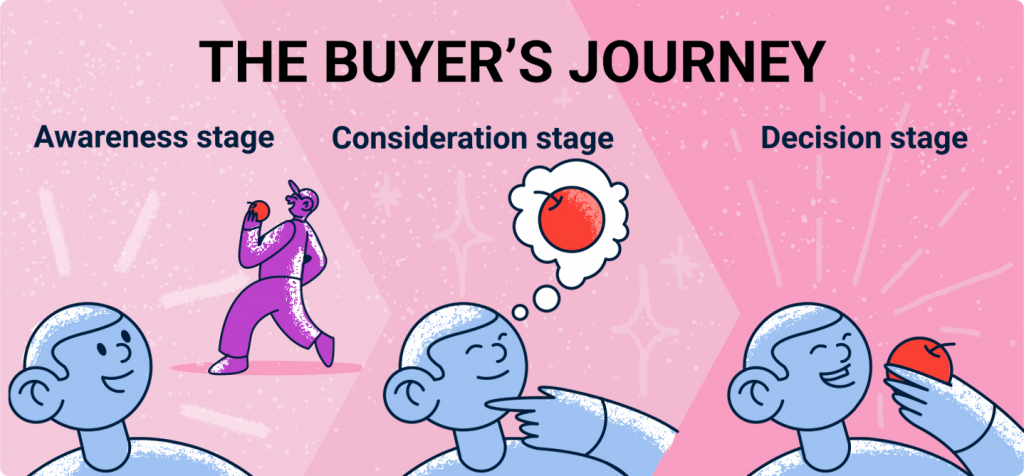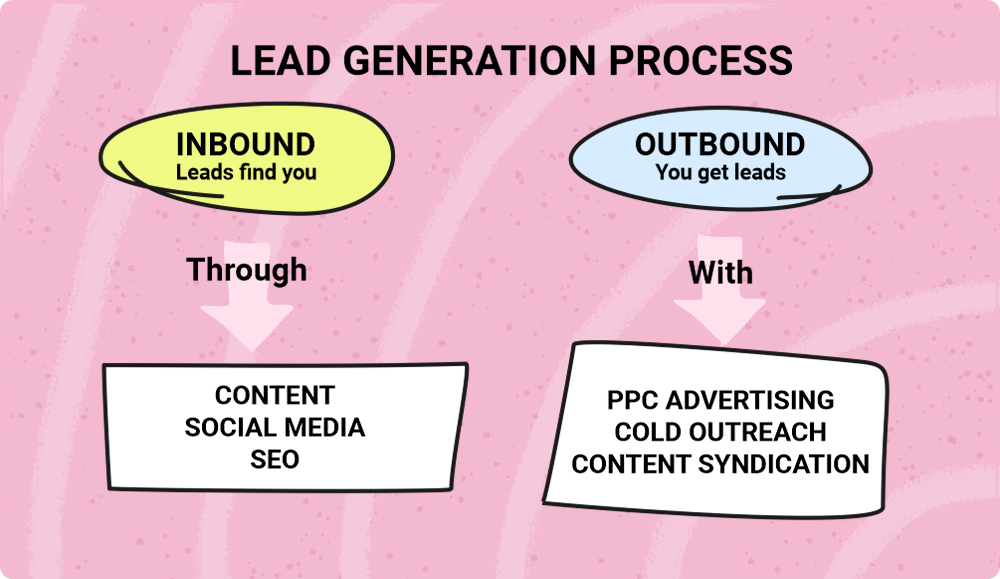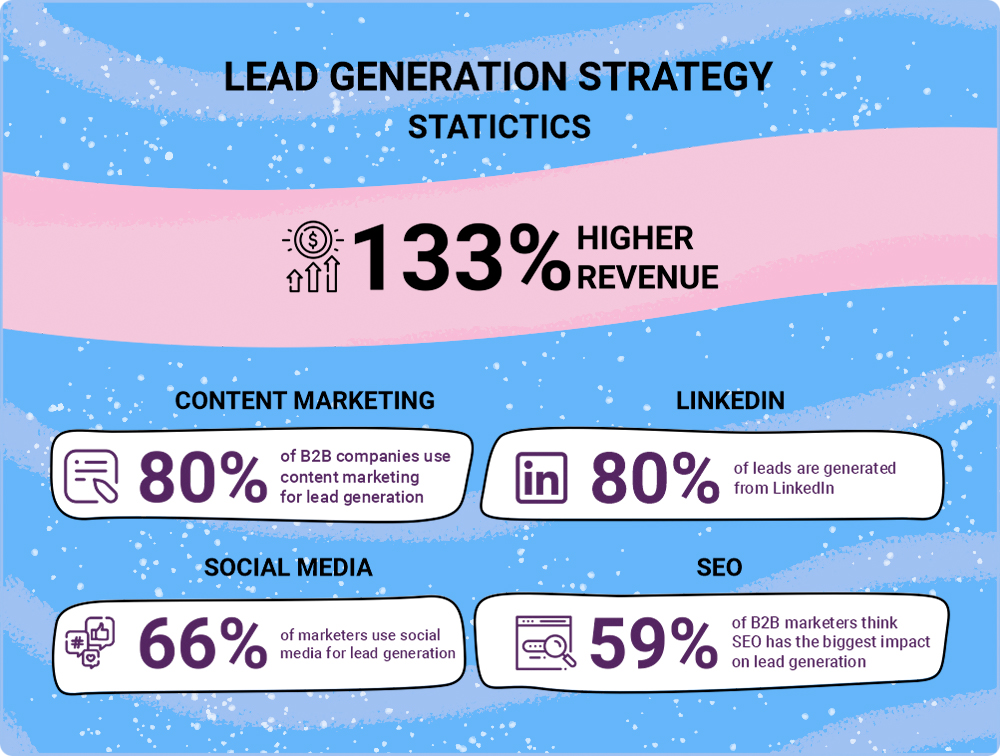Lead generation
You’ve probably heard about the “lead generation” term many times, but what is lead generation exactly, and what should you know before developing your lead generation strategy?
Let’s find out together, starting from what a lead is, how to generate leads, how the B2B lead generation process goes, what lead gen trends are there, and how to find your first leads.
What is a lead?
A lead is a person or a company potentially interested in your product or service. Every lead consists of information that you have on them. For example, a basic lead would be a name, contact details, and company name/location/job title.
Types of leads
Now let’s have a look at how to categorize leads. We’ve defined three main ways you can do it:
Lead type 1: Based on interest
Interest is the first point that helps you define leads and split them into two subgroups:
- Warm, or inbound leads, are the ones who showed their interest by themselves and found you on their own (for example, they came across your blog and subscribed to your newsletters).
- Cold, or outbound leads, are a subgroup of leads generated by you thanks to your targeting strategy and lead generation tools.
Outbound lead generation is rightfully considered more difficult than inbound due to the complexity, time, and effort needed from the sales team side.
Lead type 2: Based on enrichment
The second type is based on the information you have on your leads. Depending on the amount of data you have, you can divide them into two subgroups:
- Non-enriched leads are thin on information. Most often, they only have a name and an email address or a phone number (one contact method).
- Enriched leads come with a set of additional information you can use for personalization and multi-channel marketing: secondary contact details, company name, location, job position, pain points, etc.
Lead type 3: Based on qualification
This type helps define leads based on their qualification and stage in the sales funnel:
- Marketing qualified lead (MQL) has an interest in you but is still not ready to communicate. Let’s say, they’ve subscribed to your blog newsletters or signed up through your lead magnet, leaving their contact information in exchange.
- Sales qualified lead (SQL) has expressed actual interest in your product and is one step closer to becoming a paying customer. For example, such business leads leave their contact information to get in touch with your sales team to learn more details about your product.
- Product qualified lead (PQL) has taken action to become a paying customer. They are similar to SQLs but with a slight difference: PQLs are typical for companies that provide a free trial (like Snov.io). These leads may be using your free trial but are asking you about some of the features available in paid plans only.

What is lead generation?
Now that we’re done with the lead definition, let’s dive deeper into lead generation meaning and what it entails.
Lead generation is a process of searching for people who may be potentially interested in your service and getting in contact with them to communicate further and convert. It coincides with the first step in the buyer’s journey – the awareness stage.

→ Want to skyrocket your lead generation? Choose a LinkedIn automation tool and utilize this social media platform to expand your prospect database!
Importance of lead generation
The lead-to-customer conversion rate is never 100%. This is why filling in the sales funnel with quality leads is the main lead generation purpose. The importance of getting quality leads is obvious. It helps you:
- Target the right people. You focus your resources on specific customers who are more likely to buy your product or service. This results in saved time and money, streamlining your company’s processes and growing sales.
- Build brand awareness. Lead generation always entails educating your leads on your company and its product — both when they get to know about you on their own or when you reach out to them with the information about your product’s features. Leads can then spread information about your brand by word of mouth, bringing you even more clients.
- Get valuable data. As a rule, generating leads means collecting information about your prospective customers, their wants and needs, and your competitors. This helps you improve your product or service so that it has a competitive advantage in the market.
- Grow revenue. With an effective lead generation strategy, your company can get 133% more revenue than you’ve planned.
Who should conduct lead generation in my company?
Lead generation is a step-by-step process conducted by two groups: sales reps and marketers:
The sales group usually focuses on generating cold leads and then using them for cold calling, cold emailing, and cold marketing campaigns. They go for quantity first, qualify leads, and then work closely with the most engaged ones.
The marketing group focuses on generating warm leads. First, they acquire business leads through different marketing channels, warm them up with relevant approaches, and then forward hot leads to the sales department or make the sale right away.
Sales and marketing have different methods and needs, but the goal is always the same — a client, a deal, a sale.
→ Generate high-quality leads with Snov.io’s Email Finder an LI Prospect Finder extensions!
Types of the leads generation process
The leads generation process depends on the marketing methodology, i.e., how customers get to know you: whether they find you (inbound lead generation) or you find them (outbound lead generation).
Inbound lead generation
The inbound online lead generation process is permission-based, meaning that your potential customer finds and decides to interact with you on their own. It consists of the following steps:
- A potential customer discovers your company by visiting one of your marketing channels (your website, blog, social media page).
- They react to your call-to-action (CTA) by clicking on a button or a link that contains a message encouraging them to take some action.
- They are sent to your landing page, where they fill out a form in exchange for a valuable offer (any lead magnet you create), this way becoming your leads.
Outbound lead generation
Outbound lead generation is interruption-based, meaning you find those people who are more likely to become your customers. You contact them directly with the aim of communicating your brand and delivering your sales pitch. It embraces the following stages:
- You identify your leads (people who match your ideal customer profile), determine their needs, and think about how you can help them.
- You do research: look for leads’ contact information, collect it, and keep it organized.
- You reach out to your leads via cold emails, cold calls, or social networks.

Lead generation strategies
Now that you understand the difference between inbound and outbound types of the lead generation process, let’s focus on the lead generation strategies you’ll be using for each case.
Inbound lead generation strategies
The inbound way of getting new leads rests on lead generation marketing. The latter consists in finding promotional channels that will attract your potential customers. The sources of inbound leads vary depending on the niche (most common being content marketing, social media, and search engines).
Content marketing
71% of enterprise marketers claim they generate demand leads via content marketing. Blog posts, freebies, and infographics are only the tip of the content marketing iceberg – your imagination is the limit.
Depending on your goals and buyer persona, different content types will work better than others. So, analyze and focus your efforts on content that attracts the best inbound leads. Here are some examples:
- Articles and guides. Creating high-quality blog content is one of the best opportunities to generate business leads (especially B2B sales leads) because it brings people to your page and positions you as an expert. Do thorough research before you write any article, optimize texts, and share only relevant content.
- Lead magnet. This can be any downloadable content you’re willing to give away for an email or relevant information. It can include e-books, cheat sheets, studies, examples, etc. Once verified, use collected emails to send highly personalized and targeted campaigns.
- Videos. People perceive information better through videos. Create videos based on the same ideas as for any written content, as long as they solve the lead’s questions. Don’t forget to insert a link that will lead your viewers to an opt-in form, lead magnet, landing page, etc.
- Podcasts. They are a great way to generate new leads, as they have become an integral part of our drives to work and professional self-development. 1/3 of adults aged 25-34 listen to podcasts monthly and 1/5 – weekly. So, if your business niche allows, try involving them in your inbound lead gen strategy.
Social media
About 66% of marketers generate leads from social media after spending only 6 hours per week on social marketing.
Using social media, you can combine blogging, targeted ads, and more onto one platform and spread the word of your business far and wide. Each platform has its style, positives, and negatives, but inbound leads will find you there, especially if you engage in targeted sponsored postings and ads.
SEO
Around 59% of B2B marketers think SEO has the biggest impact on lead generation. When people are looking for products, services, and solutions to their problems, you want to ensure your lead generation website is the first thing they see. For that, fill your content and pages with keywords and phrases that correspond to these search queries.
Dedicate particular attention to search inquiries. Sustaining off-page SEO is possible with Links Management, which helps you connections with other websites and get many backlinks. Such approaches will also take you to the desired lead generation goals.
Outbound lead generation strategies
Leads that are found can be harder to convert because they have not taken an interest in your offer voluntarily. However, using specific targeting and personalization, the so-called cold leads can be converted just as easily.
Among the widespread outbound lead generation strategies are pay-per-click (PPC) advertising, cold outreach, and content syndication. PPC is a paid option, while lead sourcing can be both paid and free, manual and automated.
PPC advertising
Even though PPC advertising is effectively used to enhance inbound marketing, paid lead generation can also be a key to massive sales. You can run paid ads through Facebook, Google Search, ad networks, and many other paid sources that can provide lots of targeted traffic.
Usually, such leads are captured on custom landing pages created specifically for every campaign. Paid lead generation marketing campaigns also have more detailed lead capturing forms. This is done for a simple reason – you pay money for traffic, and you want your business leads to be as targeted and enriched as possible from the beginning.
This is a great method if you know your perfect target audience and have sales resources to process many warm leads. However, when planning a campaign, you should always answer two vital questions: Do I have enough budget to spend? And how much do leads cost?
Cold outreach
Cold outreach presupposes that you first perform lead sourcing and then connect to potential leads via cold emails or cold calls.
You can conduct lead sourcing eye-to-eye while visiting any marketing or sales events or search for contacts from various sources with lead generation tools.
Many lead generation companies offer solutions that can suit any need and price. As a result, lead sourcing can cost you nothing when performed manually or with the help of free email finder tools. Here are some options how to diversify your lead generation:
- Professional social networks (you can easily get contact details of your 2nd and 3rd LinkedIn connections using LinkedIn lead generation strategy — about 80% of leads come from this platform).
- Social networks (Twitter and Facebook lead generation).
- Company websites.
- B2B directories (here’s our list of best directories for B2B lead generation).
- Search engine results (especially Google).
Define your target audience, find the right company, decide who you need to get in touch with, and use an email finder to hunt for leads.
As soon as you collect the contact information of your potential clients, reach out to them directly, either by a cold email or a cold call.
✔️ Cold email. Cold email is an effective outbound B2B lead generation strategy. It allows marketing to hundreds of potential leads, especially when you use an email marketing automation tool that lets you build highly personalized emails, adjust their timing, and track the performance of your cold email campaigns.
✔️ Cold calling. This is probably the most traditional lead generation strategy. And although it seems to have been overrun by more progressive approaches, cold calling isn’t dead. You just need to do solid research, prepare a script, think of a proper time to contact your lead, and never rest following up.
Content syndication
Although content distribution is considered an inbound strategy, you can use content syndication as an outbound tactic. For example, if you’ve published a valuable guide, use it to start a conversation with a potential lead.

Lead generation tools
If you work at scale, manual lead generation is a tough and ineffective job. You need to automate some of your processes, and that’s where lead generation tools come in handy.
Lead generation tools are software that helps you attract leads or find and contact them on your own. There are dozens or even hundreds of lead generation tools available, all categorized depending on your goals. We’ll discuss five of the most popular categories:
- Email lookup tools
- Email outreach tools
- Marketing and sales automation tools/CRMs
- Communication tools
- Advertising tools
Email lookup tools
With this software, you can automate the lead scoring process, namely, finding the email addresses of your leads. Snov.io is just one of them. It allows you to get emails from any website and social media page, automatically verifies them, and lets you create a list of targeted leads.
Other examples of email finder tools: Hunter, FindThatLead, Lusha.
Email outreach tools
Email is still one of the best tools to help you generate leads. You can do this through targeted email campaigns or cold emails you can easily build and automate with this software.
For instance, with Snov.io cold email software, you can create an email sequence, schedule follow-ups, personalize your message with the help of variables, and even A/B test your campaigns to determine the most effective variant.
Other examples of email outreach tools: Sendinblue, Prospect.io, OutreachPlus.
Marketing and sales automation tools/CRMs
There are all-in-one marketing and sales automation platforms or CRMs that combine several tools you’ll need for successful lead generation. Besides, many of them offer additional features like lead management or qualification.
For example, with Snov.io, you can not only find your perfect leads and contact them via email but segment and manage them effectively in your personal account. Meanwhile, its integration capabilities let you sync the tool with your favorite apps and CRMs for more profound functionality.
Other examples of marketing and sales automation tools/CRMs: Hubspot, Keap, Constant Contact.
Communication tools
You can generate leads by communicating with those who land on your website via special messengers. These tools are specifically designed to manage communication with your leads in one place.
Examples of communication tools: Intercom, Drift, CallPage.
Advertising tools
If you are interested in generating leads by promoting your company, you can try advertising software (unless you are aimed at driving organic traffic). These tools help you attract more people to your website.
Examples of advertising tools: Google Ads, AdEspresso, AdRoll.

Lead generation techniques
Sales lead generation is a sophisticated process that demands a lot of analysis and work. But it can be made easier (and more efficient!) with a few lead generation tips:
Use a tempting CTA
Your whole landing page should always look amazing, but your CTA must be extra alluring to motivate the lead to sign up. Use the potential buyer’s fears and desires when composing the CTA.
Optimize your website and landing pages for mobile
Almost 60% of users would never recommend a website that isn’t mobile-optimized. Make sure all elements are displayed correctly, and your lead can sign up from mobile.
Create evergreen content
Evergreen content is like a quality car – it may take more effort to create, but it will last much longer and pay off much quicker than content built of fleeting trends.
Don’t forget about email marketing
According to numerous research, email marketing is still the best choice for business in 2023. Take advantage of it to nurture leads, onboard, share updates, and, of course, sell.
Be regular and consistent
When people subscribe, they expect something more than just one email. Create an email drip campaign with valuable content and choose the optimal email frequency to always be on your leads’ minds.
Create a referral program
Word of mouth works great in any business. So, let your clients share a referral link to bring you new targeted leads for a small bonus or reward.
Combine lead generation strategies
Ensure leads don’t stop filling your sales funnel. If you see that inbound marketing isn’t bringing you as many leads as you need, take matters into your hands, try outbound lead generation strategies, and rely on lead generation tools.
B2B lead generation trends 2025
Lastly, here’s a list of lead generation trends we recommend you to consider, as they’ve proven to perform well when it comes to attracting more leads:
- Chatbots. Among a wide range of features, they now offer lead generation. You can insert any question into the chatbot, from “What are you searching for?” to “Leave your email address, and we will send you a freebie.” They are a great choice for small teams as they are fully automated with no human oversight.
- Video guides. Use them to divert traffic to your website, for onboarding, or social updates.
- Segmentation + personalization. When you segment leads, you can reach them easier and faster, and personalized content will help you convert even more.
- Influencer marketing. Influencers are your shortcut to reaching a wide audience in your niche while boosting your brand awareness and image. A few years ago, only B2C companies used influencers. Not anymore – B2B micro-influencers can help you score your white whale!
Wrapping up
Generating leads can be a lot of work, but it pays off. There are many solutions on how to get leads; all you have to do is try to find lead gen channels that are best for you and your business.
We recommend you start with lead sourcing as you can run such lead generation marketing campaigns at no or low cost and get high-quality targeted leads. But don’t be afraid to use email finder tools too.
Go and launch your lead generation campaign today, implement the LinkedIn Automation Tool for maximum results, and let Snov.io help you on your way to getting quality leads!

















